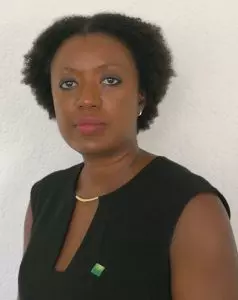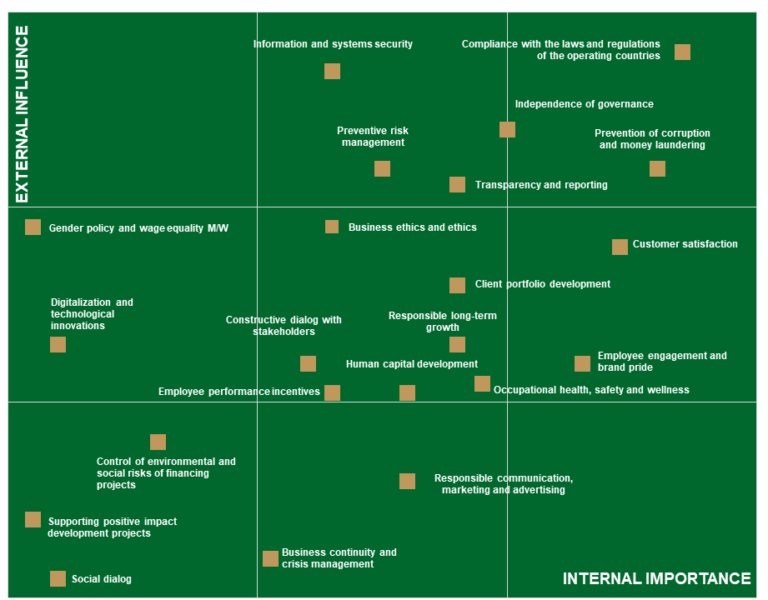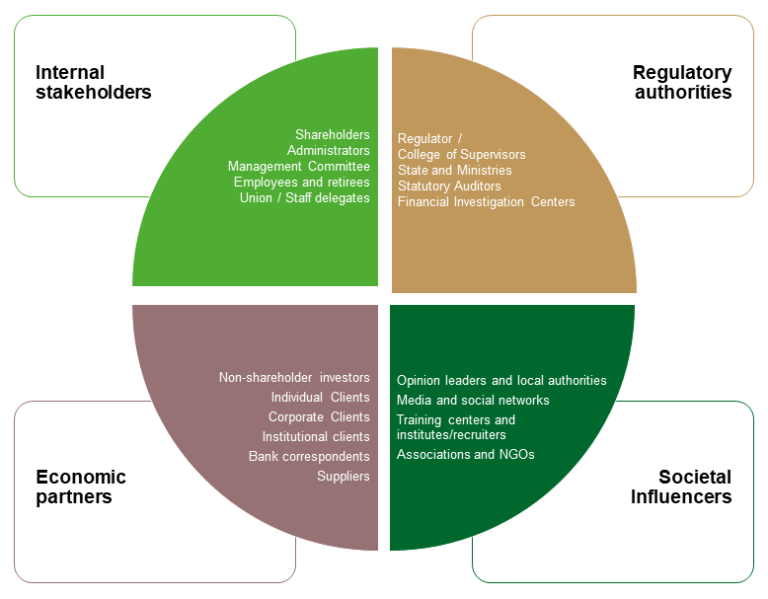Materiality and stakeholders
The Orabank Group is committed to meeting the expectations of its stakeholders. For example, we conducted a materiality study in 2017, which allowed us to draw our materiality matrix and then shape our strategy. Since then, we realize a dynamic materiality by taking into account the issues that evolve in our banking business.

The desire of the Orabank Group is to build relationships of trust, both harmonious and lasting, with its various partners. We are committed to listening to them conscientiously, providing them with concrete solutions with responsiveness and supporting them with integrity.
In May 2017, Orabank carried out a materiality analysis with the support of MATERIALITY-Reporting, a specialized company. To map CSR issues, the Group followed GRI standards and international and sectoral benchmarks. A seminar brought together the heads of communication from the 12 countries for foresight work. Orabank Group Executive management has expressed its views on the key issues for the Group’s development that has been structured in several stages, made it possible to draw the materiality matrix on the basis of which we built our CSR strategic plan.
Stakeholders
Following the principle of materiality, we conduct a stakeholder-driven assessment to identify material issues that reflect the significant economic, environmental, and social impacts, and/or that substantively influence the assessments and decisions of our stakeholders. This process allows us to identify and address concerns and priorities commonly shared by the Orabank Group and our stakeholders. We refer to the ISO 26000 Guidance on Social Responsibility to identify our stakeholders.
The methodology for stakeholder engagement is based on GRI standards. A literature review accompanied by an international and sectoral benchmark, followed by a study of dialog modes, allowed stakeholders to be segmented into homogeneous groups and subgroups. This stakeholder mapping was presented to the Steering Committee composed of the Communication Directorates of the countries where the company is located. A collaborative exercise was conducted to determine and validate the criticality of stakeholders.
Themes
To identify the significant themes, an analysis of the challenges facing the sector at African and international level was carried out based on the most recognized benchmarks. 150 significant themes were considered and this list was reduced to 50 key issues for the banking sector. The steering committee then prioritized and selected 25 important issues for the Orabank Group.
Study
Orabank invited 2,300 key stakeholders, internal or external partners to respond to an online consultation. The survey shed light on strategic societal directions. Stakeholders expressed their views on the 25 most relevant issues. The materiality matrix helps understand key stakeholder expectations and the issues on which the strategy should be based.
Strategy
This prioritization of issues allowed us to determine our new vision in 4 strategic axes and 11 CSR commitments.
Communication
As a major economic player in West and Central Africa, the Orabank Group understands his share of responsibility for current and emerging challenges. We are committed to a corporate responsibility approach that allows us to participate in the sustainable economic development of the countries in which we operate while ensuring the overall performance of Orabank.
We integrate the interests of our key stakeholders while taking a pragmatic approach to our business. The quality of the service provided by Orabank Group to its clients depends on the men and women it employs, the commitment of the suppliers and partners with whom it collaborates, and finally the confidence in the offer of products and services offered to its clients, investors, or other beneficiaries.
Dialog
The Group has maintained relationships with its ecosystem of stakeholders for many years. The experience of this dialog allows better identification of social, environmental, or economic issues and risks. Indeed, continuous observation of the evolving expectations, needs and constraints of civil society fosters better mutual understanding.
The resulting benefits are better risk and conflict prevention and the adaptation of the Group’s guidelines to changes in the world, sociological, technological, or institutional, and the development of opportunities for value creation on these topics.



